Nazi Anti-Semitism Destroyed Berlin Fashion Industry
By Sarah Moosazadeh | sarah@atljewishtimes.com
“Berlin has a distinct flavor and offers a lot of opportunities to diverse groups,” German Consul General Detlev Ruenger said at the opening of the exhibition “Fashioning a Nation: German Identity and Industry 1914-1945.”
The opening was one of three panel discussions planned around the exhibit, hosted by the Goethe Zentrum Atlanta – German Cultural Center. The second, “Creativity vs. Commerce: What Shapes the Face of Fashion?” was held Jan. 12, and the third, “Fashioning Wellness: How Wearable Technology Improves Personalized Wellness,” was scheduled for Thursday, Jan. 19, at the Atlantic Station offices of law firm Nelson Mullins Riley & Scarborough.

Clark Atlanta fashion designer Cynthanie Sumpter (left) and one of her students, senior LeNora Clarice, flank the memorial dress they fashioned to commemorate Kristallnacht.
The exhibit offers a glimpse into Germany’s fashion industry before World War II, when it was dominated by Jews, and after the war by displaying dresses from the period.
The opening night discussion, focused on the Jewish role in German fashion, featured Uwe Westphal, the author of “Ehrenfried & Cohn: Goodbye Berlin — The Last Fashion Show”; Dina Gold, senior editor at Moment Magazine and author of “Stolen Legacy,” about the Nazi theft of the Berlin building where her great-grandfather established a fashion house in 1850; Sarah Phillips Collins, the associate chair of fashion at the Savannah College of Art and Design; Christopher Charlton, a descendant of the Jewish family who owned the department store S. Adam in Berlin; and moderator Sally Levine, the executive director of the Georgia Commission on the Holocaust.
“We wanted to bring the authors, the exhibit and history together and decided to create the panel,” German Cultural Center program assistant Michaela Schulze said. “The younger generation thinks fashion is creative and fun, but they have little knowledge about the history of fashion.”
Clark Atlanta University lecturer and fashion designer Cynthanie Sumpter presented a dress she and her students designed in memory of Kristallnacht and the Jewish designers killed in the Holocaust.
The bodice is woven from strips of craft paper, to symbolize the mix of fabrics available to Jewish-German designers. Thirty shards of glass, made of acrylic, are embedded in the woven strips and contain the names of 10 Jewish designers and 20 Jewish-owned stores lost during the war.
“I learned so much about Jewish history after watching ‘Schindler’s List’ and thought I would tell a story through design,” Sumpter said.
Levine set the tone for the discussion by quoting fashion designer Coco Chanel as saying, “Fashion is always in the time which you live. It is not something standing alone.”
“This couldn’t be truer about Jewish-German fashion in Germany after World War I and II,” Levine said.
Berlin underwent mass industrialization early in the 20th century, and as women joined men in the workforce, Jewish tailors created ready-to-wear clothes, or Konfektion.
After couture fashion houses closed in Paris, Berlin became more independent stylistically and started its own trends.
“Fashion and art suddenly became one,” Westphal said. “Creative and innovative fashion by Jewish-German designers created the Roaring Twenties.”
Charlton’s family established S. Adam in 1863 and succeeded in selling men’s and women’s fashions. After the sons took over the business, they expanded S. Adam to retail stores and distributed raincoats. They represented the British company Burberry and sold to affluent clients in Germany and Asia.
The department store survived the Great Depression but crashed in 1938 because of Nazi anti-Semitism. The Gestapo arrested Charlton’s grandfather before he immigrated to London and was released with help.
“My grandfather came out of London a broken man,” Charlton said. “He considered himself German, of the Jewish faith, and never believed what happened would happen.”
Between 1933, when Hitler won political power, and 1939, the Nazis collected all Jewish businesses, Westphal said.
“They did it all legally, and even if it wasn’t legal, the government changed it to become legal,” Levine said.
Westphal cited one example of the industry’s change: “Hugo Boss designed SS uniforms, but the company has never taken responsibility. The fashion industry has never said, ‘We will cough up money.’ ”
After the Holocaust, Jewish-German tailors who survived re-established themselves in New York and London, but they found their new environments difficult.
“Today, Berlin only teaches fashion as far back to the 1950s; they don’t go further back,” Westphal said. “Talent is lost from the 1920s and ’30s, and when you don’t pick up on that, you lose a new generation of designers.”
“Manufacturing plays a big role,” Collins said. “Especially in the U.S., we don’t see how it relates to other countries that have lost that knowledge and talent and have no new designers. Students need to learn about ownership within the fashion industry — this means at a personal level and understanding history.”
Fashion Week has become relevant again in Berlin since 2007, largely because of an influx of talent from Israel, Westphal said.
Ruenger said Berlin had 3.9 million residents, including 170,000 Jews, in 1920. Now the city has 3.5 million people, including Germany’s largest Jewish community: 10,000 people.
Berlin continues to search for new designers more than 70 years after the war.




comments